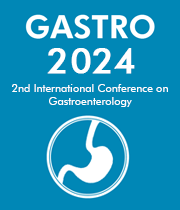Title : A case of Incidental finding of Type 1 autoimmune pancreatitis with concurrent IgG4 related sclerosing cholangitis accompanied by lymphadenitis
Abstract:
We present a case of a 69-year-old asymptomatic male incidentally diagnosed with acute pancreatitis on imaging and subsequently found to have autoimmune pancreatitis with concurrent IgG4 sclerosing cholangitis. Patient had a favorable response to steroid therapy but relapsed due to having high risk features of nodal involvement and high levels of IgG4. Although nearly all patients respond to treatment, there are high rates of remission or relapse within one year. This case recognizes the need for prolonged steroid therapy for patients with high risk features to further prevent relapsing disease despite immediate resolution of symptoms.
Case Presentation:
A 69-year-old male with a history of type 2 diabetes, treated Hepatitis C undergoing outpatient evaluation of lower urinary tract symptoms was incidentally found to have findings consistent with acute pancreatitis on CT scan with elevated lipase and amylase further supporting the diagnosis. On initial presentation, the patient was asymptomatic. Later, while overseas on a trip to Iran, the patient subsequently developed jaundice, postprandial diarrhea, and unintentional weight loss of 15 lbs. Labs demonstrated elevated liver enzymes with AST 79 U/L and ALT 75 U/L, and total bilirubin of 7.2 mg/dL. MRCP showed smooth narrowing of the common bile duct (CBD) and subsequent EUS/ERCP revealed distal CBD stricture and porta hepatis lymph nodes. Initial biopsies of the distal CBD stricture, porta hepatis, and brush cytology were unremarkable. Biliary stents were placed at the stricture site. PET scan showed mild uptake in the portacaval lymph node and bilateral mediastinal and hilar lymph nodes. Labs then revealed significantly elevated IgG4 levels of 519 mg/dL and borderline high total IgG of 1493 mg/dL consistent with AIP and IgG4-SC. He was subsequently placed on prednisone for three months which improved his symptoms. Repeat EUS/ERCP three months later showed relapse of the disease with two enlarged lymph nodes in the peripancreatic region with a thickened bile duct wall and diffuse pancreatic soft tissue changes. Fine-needle biopsy of both peripancreatic lymph nodes and brushings with cytology from the distal bile duct stricture revealed IgG4 cells comprising 40% of total IgG cells. Repeat labs showed increased IgG4 level of 669 mg/dL and total IgG of 1754 mg/dL. Patient was restarted on prednisone. Repeat CT scan then showed resolution of previously seen changes of AIP. Repeat EUS/ERCP at four months also showed improvement of pancreatitis, resolution of biliary stricture, and decreased mediastinal lymphadenopathy indicating good response to steroid therapy. All biliary stents
were subsequently removed and the patient was placed on a long term low dose prednisone for a duration of three years.
Discussion:
IgG4-RD a chronic immune-mediated fibroinflammatory disorder that often manifests with tumor-like masses and painless enlargement of multiple organs. In our patient it manifested as IgG4 related pancreatitis also known as AIP with association of IgG4-SC accompanied by lymphadenitis. Prevalence of IgG4-RD is 80% in males above the age of 50 and IgG4-SC is a common finding in >70% of cases reported. It commonly manifests as obstructive jaundice, weight loss and minimal abdominal pain, as in this case. Diagnostic criteria include typical histology, imaging with pancreatic or biliary involvement, serology (IgG4>140 mg/dL or 0.86 g/L), other systemic organ involvement and response to steroid treatment. In this case, the patient met diagnostic criteria with the following: biopsy results with IgG4 levels >40% of total cells, IgG4 levels >4 times normal, extrapancreatic involvement, and excellent response to steroid therapy. Guidelines recommend treatment of IgG4-RD with prednisone for a duration of 3 months, including taper. However, patients with high risk features of relapse require prolonged treatment with low dose prednisone for up to 3 years. As in this case, our patient relapsed in the setting of nodal involvement warranting need for prolonged immunosuppressive therapy. Typical high risk features include: IgG4 levels >4 times normal before treatment, persistently high IgG4 levels after treatment, diffuse enlargement of the pancreas, proximal type IgG4 cholangiopathy, and extensive multi organ involvement. Recurrence of disease can occur in up to 60% of patients after initial response to prednisone.
Audience Take Away:
-
IgG4-RD is chronic autoimmune mediated disease that affects multiple organs but more commonly presents as AIP with concurrent IgG4-SC.
-
IgG4-RD is treated with glucocorticoid taper for a duration of 3 months.
-
Although nearly all patients respond to treatment, there are high rates of remission or relapse within one year. Prolonged steroid therapy for patients with high risk features is needed to prevent relapsing disease despite immediate resolution of symptoms.
-
Recognize that relapsed IgG4-RD may be related to high risk features that require prolonged low dose glucocorticoid therapy for 3 years.



